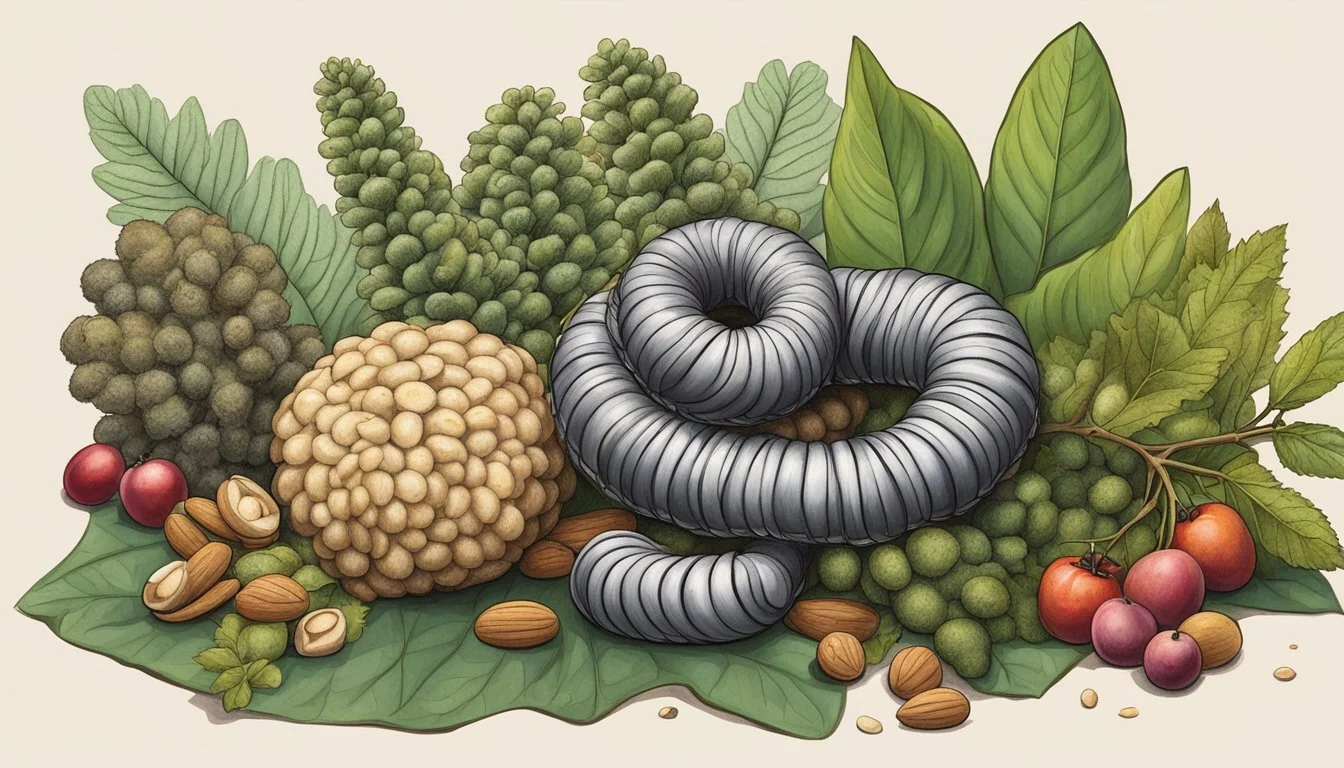Witchetty Grub
The Nutritional Powerhouse of Australian Bush Cuisine
The Witchetty grub has long been a part of the traditional diet of Indigenous Australians, a testament to the land's rich bounty. These grubs are large, white larvae that bore into wood, originally named after the Witchetty bush, which is common throughout Australia's Northern Territory. Significantly, these grubs are not limited to a single species but refer to the wood-eating larvae of several moth species. Witchetty grubs are most notably the larvae of the cossid moth Endoxyla leucomochla and are found in the roots of the acacia plants where they feed.
Eating Witchetty grubs is an experience tied not only to the land but also to the culture and survival of Aboriginal communities. Often described as having a taste reminiscent of almonds and a texture that is somewhat like cooked chicken, these grubs can be eaten raw or lightly cooked. Their nutritional value is appreciated, offering a high-protein bite for those who understand where and how to find them. The grub's integral role in the ecosystem and as a food source represents a key element of 'bush tucker' – the wild food necessary for the sustenance of Aboriginal peoples across varying Australian landscapes.
Australian bush tucker not only provides sustenance but also offers a glimpse into the profound connection between Indigenous people and their environment. The Witchetty grub stands out among other bush tucker for its intriguing nutritional profile and unique taste. As Australia grows more interested in sustainable and native food sources, the Witchetty grub is stepping out of the shadows of its bush heritage and into the spotlight of modern Australian gastronomy.
Understanding Witchetty Grubs
Witchetty grubs are a traditional and nutritional food source, deeply embedded in the Australian Aboriginal diet, and they have a significant biological classification and dwell in specific habitats across Australia.
Biological Classification
Witchetty grub is a common name given to the larval stage of several moth species, principally the cossid wood moth (Endoxyla leucomochla). These larvae belong to the family Cossidae, though other families such as Hepialidae and Cerambycidae (longicorn beetles) also have species with larvae referred to as witchetty grubs locally. These grubs are notorious for their wood-boring habits, which is a defining trait of the group.
Classification Summary:
Kingdom: Animalia
Phylum: Arthropoda
Class: Insecta
Order: Lepidoptera
Family: Cossidae (commonly)
Habitat and Distribution
Witchetty grubs primarily inhabit the arid regions of Australia. They're known to burrow into the roots of the witchetty bush (Acacia kempeana), drawing nutrition from the plant's sap. The cossid wood moth larvae, which the term 'witchetty grub' most accurately describes, are widespread throughout the Northern Territory and can also be found in other parts of the country. Their habitat spans below-ground, roughly 60cm deep, which provides them a shield from the desert's extreme conditions and predators.
Culinary Significance of Witchetty Grubs
Witchetty grubs hold a distinctive place in Australian Aboriginal cuisine, revered for their nutritional density and unique taste profile. They are an edible insect that provides both a sustainable protein source and a cultural culinary experience.
Nutritional Value
Witchetty grubs are a rich source of protein, essential for muscle repair and growth. They are also easy to digest, making them a suitable food for all ages. The grubs contain important fats, which are vital for energy and cell structure.
Protein: High content, comparable to traditional meats
Fat: Healthy fats for sustained energy
The nutritional profile of witchetty grubs makes them an excellent alternative to conventional meats, offering both environmental and health benefits.
Traditional Preparation Methods
Traditionally, Witchetty grubs are either eaten raw or cooked. Aboriginal methods involve roasting the grubs on hot ashes or coals, which gives them a barbecued finish with a nutty flavor.
Raw Consumption: Directly eaten live and whole
Cooked Grubs: Roasted over coals until the skin is crisp
These preparation techniques have been passed down through generations and remain a testament to the grub's versatility in Aboriginal food culture.
Contemporary Witchetty Grub Dishes
In modern Australian cuisine, Witchetty grubs are sometimes featured in a more contemporized form. They can be found in gourmet dishes, utilizing their unique flavor which is often described as akin to almonds.
Dish Examples: Integrated into pasta sauces, stir-fries, or as a pizza topping
Cooking Methods: Sautéing or infusing into sauces
Chefs who embrace these edible insects are finding innovative ways to incorporate the traditional bush tucker into modern dishes without compromising their distinctive taste and nutritional value.
Cultural Impact in Australian Indigenous Communities
The relationship of Indigenous Australian communities with the witchetty grub is profound, affecting cultural narratives and dietary practices for many years.
Witchetty Grubs in Indigenous Australian Diets
The witchetty grub has long been a significant source of protein for Indigenous Australians, particularly for the Pitjantjatjara people. These edible larvae are sourced from the roots of the witchetty bush, known scientifically as Acacia kempeana. The process of harvesting them involves Aboriginal women and children who expertly dig around the roots to collect these grubs. The indigenous name given by the Adnyamathanha people to witchetty grub is "witjuri", highlighting the creature's importance in the local language and identity.
Cooking method: The grubs can be eaten raw for their almond-like taste or lightly cooked to idealize their flavor.
Cultural Lore and Dreamings
Witchetty grubs are interwoven with cultural lore and dreamings, which are pivotal to the ontology and spirituality of many indigenous groups, including the Adnyamathanha people. Dreamings, or Tjukurpa in the Pitjantjatjara language, are intrinsic to the cultural narratives that explain the origins of the people and their land. The witchetty grub holds a place in these narratives, symbolizing sustenance and survival in the often harsh central Australian landscape.
Totemism: For some communities, the grub is a totemic animal, embodying ancestral spirits and informing cultural practices and taboos around its use and consumption.
The witchetty grub's role in the diet and culture of Indigenous Australians is a testament to their resilience and deep connection to the land.
Witchetty Grubs in the Australian Ecosystem
Witchetty grubs are not just a traditional food source for Indigenous Australians, they play a specific role in the ecology of Australia's arid regions where plants like the Acacia kempeana, commonly known as the witchetty bush, thrive.
Symbiotic Relationships
Witchetty grubs (the larvae of the cossid wood moth Endoxyla leucomochla) engage in a symbiotic relationship predominantly with the Acacia kempeana and river red gum tree. They inhabit the woody roots of these trees, consuming the root sap which forms the cornerstone of their diet. While doing so, they indirectly contribute to the aeration of the soil which can benefit the host plants by improving root respiration.
Impact on Local Flora
The grubs, however, have a complex impact on the local flora. Their feeding habits can lead to:
Reduced vitality of individual Acacia kempeana trees due to significant root damage.
Increased susceptibility of affected trees to other stressors such as drought, thereby influencing their survival rates in the harsh Australian desert ecosystem.
On the other hand, the decay of grub-inhabited roots potentially facilitates nutrient cycling and may ultimately support the growth of surrounding plant species. As the grubs metamorphose and vacate their burrows, these channels may be colonized by other organisms, further integrating the witchetty grub into the fabric of the Australian bushscape.
Gathering and Hunting Practices
The Witchetty grub has been a staple in the diet of Indigenous Australians, with specific traditional techniques for gathering this bush tucker food. Whether dug up from the roots of the witchetty bush or sourced from beneath the ground, these practices were pivotal to sourcing these nutritious wood-boring grubs.
Traditional Techniques
Traditionally, Indigenous Australians have honed methods to gather the Witchetty grub, a vital source of protein. Gathering involves searching for telltale signs on the ground, such as tiny mounds of earth that indicate the presence of grubs. Once located, the grubs are dug up carefully to avoid damage. The primary diet of the larvae includes the sap from the roots of the witchetty bush, which contributes to their size and nutritive value.
Hunting for these grubs also entails observing the activity of birds or other animals that may feed on them. This is a discreet approach that relies on the understanding of the ecosystem and how various species interact, especially when it comes to finding other bush tucker like native gooseberries and bush potatoes.
Contemporary Harvesting
In modern times, the harvesting of Witchetty grubs for both local consumption and commercial purposes still respects traditional methods but can be supplemented by tools that aid detection and extraction. Extraction tools include small shovels or digging sticks, which are now sometimes made of metal rather than traditional materials.
Despite increased interest in these protein-rich larvae, sustainable practices are maintained to ensure that neither the bush tucker supply nor the ecosystem is compromised. Contemporary foragers also look for grubs in the broader bush, where they might infest roots of various native plants, such as yams, besides the witchetty bush. The focus remains on harvesting these grubs in a way that respects traditional values while acknowledging the continued importance of bush tucker in Australian culture.
Integrating Witchetty Grubs with Other Foods
Witchetty grubs are a versatile ingredient in the Australian bush tucker pantry. They can be adeptly combined with traditional Aboriginal foods and contemporary ingredients to create dishes that are rich in flavor and cultural history.
Pairings with Native Ingredients
Pairing witchetty grubs with native Australian ingredients can bring out a symphony of flavors. Here’s how they can be complemented with various foods:
Meat: Witchetty grubs have a nutty taste and can be a unique addition to meat dishes. For instance, when grilled, they can top a kangaroo tail soup or be incorporated into an emu fillet stuffing, enhancing these gamey meats with their unique flavor profile.
Seafood: Incorporating witchetty grubs in seafood dishes (What wine goes well with seafood dishes?) such as those with flathead fish, can add a surprising twist. They can be pureed and added to a peanut sauce to accompany prawns, or used as a garnish on a fish dish, where their creamy texture contrasts the firmness of the fish.
Fruits and Vegetables: As for fruits and vegetables, consider dicing witchetty grubs and combining them with lady apple or plum slices for a sweet and savory salad. The soft witchetty grubs balance well with the crispness of these fruits.
Meats: Topping for kangaroo tail soup, stuffing for emu fillet
Seafood: Pureed in peanut sauce for prawns, garnish on flathead fish
Fruits: Combined with lady apple or plum slices in salads
Vegetables: Added to dishes with warrigal greens or sea celery
Plant-based Pairings: Crushed witchetty grubs can be mixed with bunya nuts (What wine goes well with nuts?) or green ant infused sauces for a rich, creamy texture. Warrigal greens can be sautéed with diced grubs for a healthy, hearty side.
Seeds and Nuts: For crunch, consider toasting and tossing them with almonds or as an adjunct to seeds in various dishes.
In summary, witchetty grubs harmonize well with traditional Australian meats such as kangaroo and emu, while also bringing a nutty depth to seafood and vegetable dishes. Utilizing fruits such as quandong or lady apples can highlight their subtle sweetness. When integrated thoughtfully, witchetty grubs can elevate a meal, providing not only a conversation piece but also nutritional value and authentic taste of Australia's bush tucker heritage.
Preservation and Sustainability
The Witchetty Grub is an integral part of the ecosystem in the Australian Outback, playing its role in maintaining the health of native flora. Sustainable practices and conservation efforts are vital to ensure its continued existence and to respect its significance in Indigenous culture.
Conservation Efforts
Researchers in Australia are focused on understanding the Witchetty Grub's life cycle and habitat to aid in conservation. By utilizing DNA analysis, they are able to track genetic diversity and monitor populations of these grubs, especially in areas where land use has changed.
Sustainable Farming Practices
In the Australian Outback, farming practices that support the Witchetty Grub's lifecycle and natural habitat are considered crucial:
Minimal interference: Limiting soil disruption to protect larvae in their native environment.
Indigenous knowledge: Incorporating Indigenous methodologies that are proven to be sustainable for harvesting grubs.
Crop selection: Planting flora like the Witchetty bush, which is beneficial to the grub's development and the stability of the ecosystem.
Recognition Beyond the Bush
Witchetty grubs have transcended their traditional role in bush tucker, earning culinary and cultural recognition that extends far beyond the remote outback of Australia.
Witchetty Grubs in Modern Australian Cuisine
Modern Australian chefs have embraced the witchetty grub, incorporating this indigenous ingredient into contemporary dishes. While retaining its roots in the indigenous diets of Northern Territory, South Australia, and Western Australia, witchetty grubs have found a new audience in urban restaurants. Here, they might be served roasted or sautéed, praised for their taste, which is often likened to almonds or other nutty flavors.
Examples in Modern Cuisine:
Roasted Grub: Served on a bed of local greens
Sautéed Grub: Prepared with indigenous herbs and spices
International Awareness and Appetite
Globally, the witchetty grub has sparked curiosity as a sustainable food source high in protein. This interest has been partly fueled by exhibitions in institutions such as the Australian Museum, which educate visitors on bush tucker and the diverse dietary practices of indigenous Australians. Chefs and food enthusiasts beyond Australia's borders have begun experimenting with witchetty grubs, considering them a novel delicacy and an exemplar of traditional foods.
Factors Contributing to International Interest:
Protein Content: Comparable to conventional meats
Sustainability: Heralded as a low-impact food source
Cultural Significance: Represents a window into indigenous food practices
Health and Dietary Considerations
The Witchetty Grub, as a traditional food source for Indigenous Australians, offers significant health benefits. This section examines its nutritional profile in terms of digestibility and allergens, as well as its role in various diets.
Digestibility and Allergens
The Witchetty Grub is high in protein and fat, making it not just a unique culinary item but also a valuable dietary component. Its larvae form is composed of soft tissue, which is generally considered easy to digest for most people. However, as with any insect-based food, individual allergies to this kind of protein source should be considered.
Inclusion in Diverse Diets
Witchetty Grubs are a versatile component in the food culture known as "Bush Tucker." They can be incorporated into diverse diets, catering to those seeking alternative sources of protein. As global interest in sustainable and varied protein options grows, Witchetty Grubs could find a place in many diets, underlining the importance of traditional foods in modern consumption patterns.
Challenges and Controversies
Exploring the complexities behind consuming witchetty grubs, one must consider the environmental impacts and the ethical questions that arise, each playing a critical role in how this bush tucker is perceived and utilized today.
Environmental Impact
The collection and consumption of witchetty grubs could potentially impact local ecosystems. Sustainable harvesting methods are crucial to maintain balance within these environments. The United Nations (UN) emphasizes the need for sustainable food systems, which includes the sustainable use of insects as food. When witchetty grubs are overharvested, it may lead to a decrease in the populations of the moths from which they develop, subsequently affecting the wider ecosystem that relies on these moths for pollination and as part of the food chain.
Ethical Questions
The consumption of witchetty grubs also raises ethical concerns. As awareness grows about the sentience and welfare of all creatures, including insects, the ethics of consuming bush tucker like witchetty grubs comes into question. Some debate whether traditional practices should be adjusted or if the cultural significance of these practices warrants their continuation without change. Respect for Indigenous traditions and cultural heritage, which have included witchetty grubs as a food source for tens of thousands of years, must be balanced with modern ethical considerations related to animal welfare.
Future Perspectives
The potential of witchetty grubs as a protein-rich food source is seeing growing interest from scientific and culinary sectors. This native Australian edible insect could play a significant role in food sustainability and innovative cuisine.
Research and Development
Research into witchetty grubs is uncovering their nutritional profile, which is high in protein and offers essential amino acids. The study of their DNA is pivotal for understanding their breeding habits and life cycle, which could lead to more sustainable farming methods. Researchers are also examining the environmental impact of cultivating witchetty grubs for mass consumption, ensuring that the benefits outweigh any ecological drawbacks.
Culinary Innovations
In the culinary world, chefs are experimenting with witchetty grubs, introducing them to menus in a variety of forms. From grilled and roasted preparations to pastes that can be used in a range of dishes, the goal is to make this bush tucker more accessible. Culinary professionals are recognizing the grub's nutty flavor, incorporating it into both traditional and modern Australian dishes, thus raising its profile as a versatile ingredient.









